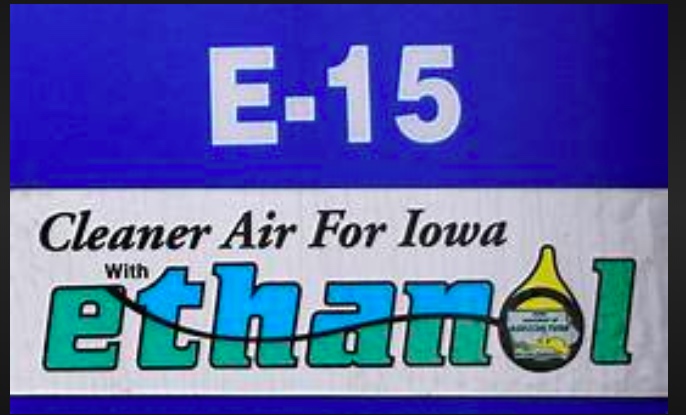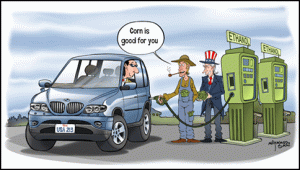“Gas” is about to become another 5 percent less so.
President Trump just issued a fuhrerbefehl – a Fuhrer Order, as it was styled back in you-know-where, by you-know-who – directing the EPA to change its befehls (orders) to infuse the nation’s “gas” supply with 15 percent ethanol (E15), year ’round.
Up to now, the limit of ethanol-adulteration – in most places, most of the time – has been 10 percent (E10).
But what’s the problem with ethanol?
Well, it there isn’t one – if you’re the one selling it. But if you have to use it, there’s a price to be paid above and beyond what you pay for each gallon.
Ethanol-adulterated fuel is several percent less energy dense than 100 percent gas.
Which is why cars burn more of it to go a given distance than they would a gallon of not-adulterated, 100 percent gas.
15 percent ethanol (E15) will decrease the distance your car can go on a gallon by another noticeable percentage.
But, wait a minute . . . isn’t the government “concerned” about fuel economy? Well, Trump is also concerned about re-election. And ethanol is of great concern to the agriculture cartels which are politically puissant in Iowa and other “corn” states where the crops which are transmuted into ethanol are grown.
Hence the new ethanol-friendly befehl.
It’s just not friendly toward us.
One of the reasons the economy cars of 30-plus years ago – back in the early ‘80s – were as or even more fuel-efficient than the economy cars of today, even though they had none of the many engineering advantages of today’s cars (such as computer-controlled port fuel injection) was due to the fact that their fuel was more efficient.
It was 100 percent gas – not 10 or 15 percent something else.
A gallon of unadulterated gasoline contains the equivalent of 116,090 BTUs of energy.
A gallon of ethanol contains 76,000 BTUs of energy.
Put another way, a gallon of ethanol contains about two-thirds the energy equivalent of a gallon of gas that’s just gas. You can see where this is headed – or just watch your fuel gauge.
The more ethanol in your gas, the less far you go. Fifteen percent ethanol – as just befehl’d – will have exactly that effect.
With an exception, kind-of, sort-of.
Ethanol is an octane enhancer. If you own a car with an engine that has a high enough compression ratio (or is turbocharged, which has the same effect – increasing the pressure inside the engine’s cylinders) the higher-octane of ethanol-laced gas can compensate for the lower energy content of the fuel by enabling the engine to run more efficiently – and make more power.
This is one of the reasons why the car industry supports higher-octane/ethanol-doped “gas.” The car companies are installing very high-compression or turbocharged engines in almost every type of vehicle made, in order to up their fuel efficiency in order to comply with the other government befehls.
But the same effect could be achieved with higher-octane gasoline sans the ethanol – and you wouldn’t be making up for lower-energy-content fuel. A gallon of 94 octane gas would take you farther than a gallon of 94 octane E10 or E15 while also enabling the high-compression/turbocharged engine to make more power. But, the high-octane stuff does cost more – negating the efficiency advantage – which is why (until recently) most cars did not come with high-compression/turbocharged engines.
And if your car hasn’t got a high-compression engine, the higher octane (ethanol-enhanced or not) doesn’t provide any benefit regardless. In fact, too high an octane can have a negative effect on mileage, because the high-octane fuel does not combust optimally in an engine not designed for it.
There are millions of such cars in circulation.
The majority of cars made before the mid-2000s do not have high-compression engines, or turbochargers – which used to be found almost exclusively under the hoods of high-performance cars and high-end luxury cars. People who buy such cars buy them because they are more powerful than family cars and commuter cars and are willing to pay extra not only for the additional power, but extra for the higher-octane fuel necessary to make it.
For everyone else, high octane fuel – ethanol’d or not – is just another unnecessary expense. They will see no benefit in terms of power from E15 fuel – but will notice a reduction in mileage, because the E15 hasn’t got as much energy per gallon.
If the ethanol were cheaper per gallon than straight gas, that would make up for the decreased MPGs – but it’s not the case. The ethanol costs as much or more than straight gas – which is why ethanol has to be forced on the market via “renewable” fuels mandates. The ethanol lobby is very much like the electric car lobby. What it sells requires coercion and without coercion, couldn’t be sold or would sell a lot less.
There’s another, more worrisome angle to this story, too.
Almost all vehicles made before the early 2000s (except those specifically made to be “flex-fuel” compatible) are not designed to safely operate on fuels with more than 10 percent ethanol content. Alcohol is corrosive and there is an increased risk of fire in vehicles not built with ethanol-compatible fuel systems, among other problems. The owner’s manuals – and warranty documents – of these older vehicles warn specifically not to use fuels with more than 10 percent alcohol content.
It’s interesting that the safety issues regarding the use of E15 in millions of still-in-service vehicles is considered unimportant by the same government which ululates saaaaaaaaafety whenever it is otherwise a convenient as a pretext for imposing something upon us – and especially for separating us from our money (and liberty).
And it’s odd that the government is pushing more ethanol into the fuel supply at just the moment in time when the United States is one the verge of producing enough oil within the U.S. to meet its needs – and on track to become a net exporter of oil within the next five years
Until you realize that – as is invariably true – ethanol isn’t about “renewability” or any other virtuous thing. It’s just another con – with the only meaningful difference between it and the kind of con that goes on in back alleys and crooked pool parlors being you can’t decline to be a mark.
. . .
Got a question about cars – or anything else? Click on the “ask Eric” link and send ’em in!
If you like what you’ve found here please consider supporting EPautos.
We depend on you to keep the wheels turning!
Our donate button is here.
If you prefer not to use PayPal, our mailing address is:
EPautos
721 Hummingbird Lane SE
Copper Hill, VA 24079
PS: Get an EPautos magnet (pictured below) in return for a $20 or more one-time donation or a $5 or more monthly recurring donation. (Please be sure to tell us you want a sticker – and also, provide an address, so we know where to mail the thing!)
My latest eBook is also available for your favorite price – free! Click here. 













This will cause problems even recent vintage cars, most of which are not built for more than E10 gasoline.
Don’t forget how bad this fuel is for motorcycles, boats, atvs, lawnmowers, etc…
Rule #1: Don’t ever purchase the cheapest per-gallon gas.
Rule #2: Always look for the “THIS FUEL CONTAINS 10% ETHANOL” label on the pumps. If you spot it, make a “bee-line” in the other direction, unless it’s an emergency and you’re running on fumes, and there are no other stations for miles.
Anyway, happy motoring! ?
Thanks to RFG and EPA containment zones non ethanol gas disappeared in my area 20 something years ago.
Yeah, I just came across this: http://www.fuel-testers.com/state_guide_ethanol_laws.html
Apparently, some states (including NJ!) do NOT require stations to label their pumps with the “10% ETHANOL” label! FUUUUUUUUUUUUU…
Eric, this development disturbs me. I have two pre 2000 cars, what am I supposed to do?
Ten years ago, the big concern was about 10% ethanol, now it’s raised to 15. Back then, it was known that ethanol was a no no for rubber parts in the engine bay.
Now it’s going to be even worse.
Is there a solution for us? It doesn’t seem like an additive would help.
I know you have a 2nd gen Pontiac F Body, mine are 3rd and 4th gen Pontiac F Bodies. Is there a solution for us that you know of?
Hi Jim,
E10 and E0 (real gas, not ethanol-doused) will still be available, along with E15. My concern is that the government (and the car industry) will nudge for E15 to become the new normal, for all the reasons laid out in the article.
I’m not sure what we can do – other than make it known we object. The problem is most people are oblivious and the forces in favor (the ethanol lobby and the pols that bend knee to it; also the car industry)) are tremendously powerful.
On an individual level, we can update our vehicles to handle ethanol-laced fuels… as I’ve done with my second generation TA. But with newer cars such as your Third Generation TA, it gets more involved and expensive. I can rebuild my 4 BBL Quadrajet for less than $100.
I’m not sure what it would cost to update a Tuned Port Injection system and peripherals.
Thanks Eric, good to know that E10 will still be available. It feels a lot like we’re being forced out of owning or at least trying to get us to give up on these older (and to my way of thinking) more desirable vehicles.
You can also remove the ethanol fairly easily by adding water to the gas. Shake it up and the ethanol will dissolve into the water, and that solution will separate from the gas.
But it could really old trying to keep a car fueled in this manner, to say the least of needing to fill up while on the road.
“could make E15 available to consumers as soon as next summer.” Doesn’t sound official or even mandatory.
Find a ‘recreational fuel’ purveyor near you. Surprisingly NY state has plenty of E0 options.
https://www.pure-gas.org/
Has anyone tried E0 in their car? Under what conditions would someone want E0? For example, my car was designed for regular so I never pump premium into it. Should I use E0 when available? Does recreational fuel have all the detergents I am convinced I need in my gas?
Just to annoy people, I found this rebuttal from the ethanol-friendly people at Fuel Freedom:
We rebut a baker’s dozen of dubious claims about ethanol
https://www.fuelfreedom.org/rebut-dubious-claims-ethanol/
I’ve run E0, I get it from a store by a lake that caters to outboard motors, and the only difference I see is about a 3-4 mpg increase in fuel economy. Which just about makes up for the increased price.
Hi James,
The ethanol-doused fuel can lead to problems in older vehicles with engines not designed to handle the alcohol. Mostly, vehicles made before the early 2000s – but there are still lots of those out there.
Outdoor power equipment doesn’t like ethanol, either.
The outdoor power equipment industry is pushingethanol free pre mixed caned gasoline. I got a free sample years ago and it was good stuff. But I’m too cheap too buy it. I just make sure to either run everything often enough or go through the storage routine.
Morning, Brent!
I’m fortunate in that the station in town (15 miles down the road) sells 100 percent regular unleaded (no ethanol). I use this in my storage containers and power equipment. All my vehicles have been updated, but E15 or more will be a problem.
I am convinced that this is one of the means by which they plan to early retired the older stuff.
I reviewed that rebuttal from fuelfreedom.org, which is an organization promoting ethanol. I don’t have time or energy to rebut their rebuttal point by point, but most of their answers are either replies to strawman questions, or rhetoric designed to obfuscate the issue. When you look at their citations, they all lead back to partisan sources that are cheerleading for ethanol. Just 2 examples from the document you linked:
“CLAIM: Ethanol corrodes engine parts, including rubber fuel lines.
FACT: Materials used in cars built in the last 15 years have been rigorously tested for compatibility with ethanol in gasoline, over the entire useful life of the vehicle. Older vehicles are often compatible as well. If an engine is not compatible with ethanol, the owner’s manual will clearly say so.”
This basically just says “Newer cars don’t have a problem”. Which may be true, but is not the actual claim, which says that ethanol can harm some engines. When you go to the citation link provided, it links to an article from the same group, which literally says that the claim is TRUE! “Here’s the truth: Some older vehicles should not use any ethanol blend above E10, which is up to 10 percent ethanol and what virtually all of us use as regular gasoline. Higher ethanol blends also aren’t approved for motorcycles, boats and yard equipment.” But then it dismisses this important statement saying essentially everything is corrosive, including water, air, gasoline, etc., and “…if auto manufacturers had to make some alterations to accommodate ethanol, so what? It’s not even worth a serious discussion.” So basically, screw the people who drive older cars, or own motorcycles, boats or yard equipment.
CLAIM: The ethanol market would fall on its face without the federal mandate requiring that gasoline contain 10 percent ethanol.
FACT: Without the mandate, oil refineries could very well continue using ethanol, because it’s cheaper than the toxic, carcinogenic additives that would otherwise be necessary to bring the gasoline up to the legally required minimum octane rating.
So if ethanol would be used without the mandate, why is the mandate necessary? I also find it disingenuous that they describe ethanol alternatives as “toxic” and “carcinogenic”, as though ethanol is a healthy, safe alternative, when in fact ethanol IS toxic, and is classified by the World Health Organization as a Group 1 carcinogen, similar to arsenic, benzene and asbestos.
What they are referring to is MTBE or maybe TEL. But there are other octane enhancers or more refining can be done. MTBE was the other oxygenate that the EPA approved but it got into water supplies and was banned leaving ethanol as the only approved oxygenate. So it’s not octane that will keep ethanol around but the other mandate besides the renewable content law, the oxygenate requirement in and around most large cities and dragging most of the rest of the gasoline supply along with it.
Thanks for the back up, Zathras!
George and others are like the electric car people who refuse to concede or even directly address the functional gimps that afflict EVs and the very questionable economics of EVs.
It’s agenda-pushing, that’s all.
I have no issue – as such – with either ethanol or EVs. What I do take issue with is the force-feeding of these things – accompanied by dishonest PR which always deliberately avoids the central question: If ethanol and EVs are so wunnerful, why is it necessary to force-feed them to people?
I understand your per se argument on ethanol and EVs, but I reject those vehicles and gasohol in principle because once established, we’ll all have to dance to their tune.
I still run a variety of carburetor cars, and I’m not sure what I’ll do to start them on E15 when it’s 25 below zero in the morning.
Morning Ross,
Yeah… I incline toward the same view. The reason being it’s become clear to me that all of these things – ethanol, the heavy nudging toward electric cars – are part of a concerted effort to establish an unprecedented degree of control over our mobility. They want us out of cars that are largely under our control (this includes being able to maintain and repair them almost indefinitely and so being able to avoid the debt of a new car) and tied to a perpetual payment model and to cars which are literally under their direct control via wireless communication networks.
So, I can’t tell if they are getting rid of E10 for E15 or just adding E15 to the choices at the pump.
Should have seen this coming. Sen. Grassley , Iowa ” grows a spine” and pushes through Judge Kavenaugh in exchange for President Trump to increase ethanol to E15. More bullshit, sometimes Less bullshit. But always bullshit!
Hi Allen,
I hadn’t thought about the Grassley angle… it makes sense… sigh…
The only way this works is if there is a E0 option in all states. Currently you can get E0 in most rural states but not metro areas. Small engine manufacturers, and the AMA have been fighting this nonsense for a long time. E15 will damage most, if not all, small engines.
In a rural state I visit, the options at the typical 3 hose pumps are 87 E10, 89 E10 and 91 E0. This makes the most sense.
The way I see it, is the auto manufacturers are going to push for this, and they will win, because then they will have to redesign engines (and have been), while the rest of the world (their competitors) won’t be able to, again limiting competition. The new way to sell your stuff.
Hi Chris,
Yes. There is a concerted push – the car industry wants this, the ethanol lobby wants this and the government wants this. But do we (i.e., the free market) want this? There’s no evidence for it. If there were market demand, it would happen organically.
Same thing with regard to electric cars.
This is about top-down social engineering and profiteering.
Looking through my lubricant/fuel products shelves Sat for some oil to lubricate an electric motor I came across an old bottle of octane booster. It stopped me in my tracks for a few minutes as I began considering what might come down the pike to Reduce octane so my pickup won’t soon be using even more fuel when low octane fuel is no longer available……SHIT!!
And, what about the damage to engine components from ethanol in the gas? I had a 2006 Ford Explorer 4.0L V-6. At 70,000 miles, the engine developed an intake leak. Guess what? The damn ethanol had eaten up the intake manifold gaskets to the point that when we removed the manifold, the gaskets just crumbled into little bitty pieces. Several mechanics told me that this was nothing new, they saw it all the time. After replacing the gaskets, I gave the vehicle to my daughter. Guess what again? At 138,000 miles, it developed an intake manifold leak. This time, she just traded it off. LOL!
Hi Texas,
Yup. I “updated” the entire fuel system in my old muscle car as a preventative measure. Carb rebuilt with ethanol-compatible soft parts; new fuel pump, new stainless steel fuel lines and tank. Another expense courtesy of Uncle…
your 70s muscle car is fairly straightforward and stuff like pipes and carbs can be changed / rebuilt.
What about someone with say a car they want to keep from say the 90s to the mid 2000s…. when parts are fairly specialised, complicated, and computerised… can they ever be rebuilt, particularly with the sensors and computers they utilise… or are they just doomed to destruction thanks to Uncle……
Hi Nasir,
In my darker moments, I suspect that this stuff is deliberately intended to accelerate the retirement of the older cars still in circulation, in order to create demand for the new stuff, especially the electric stuff…
Yes, that is exactly why they are pushing this crap.
Agreed – if you look at every regulatory mandate and tax thats coming in Europe… its simply to get pre 2010-ish cars off the road……
I think that really was the sweet spot. Enough technology to make cars very reliable and efficient. But not so much that they are constantly monitoring and tracking everything you do…..
Like “cash for clunkers” but without the cash.
Hi RJ,
And much more ingenious – because it’s not so obvious. Older cars just age out sooner…
Keeping 90s and 00s cars on the road is the same as usual. Just nagging little stuff breaking. Or in the case of a mazda at 19 years old, just one thing after another. Hey, it’s only another $5,10,20,50 or 100 to repair, but it all takes time. I’ve seen this on 70s and 80s american cars too. The major stuff really doesn’t go and most of what does is primarily due to the environment and age. Namely rust.
eric, do you use the fuel filter in the Qjet and if so, is it the paper type or the sintered bronze?
Hi Eight,
I run a larger capacity in-line filter ahead of the carb, just after the fuel pump. Both for flow and filtration reasons… took her out yesterday, by the way. Glorious. Boosted my mood. Who needs drugs when you’ve got a 455 Trans Am? 🙂
eric, I’m guessing you use an electric pump with an adjustable pressure regulator? For far too long I continued using mechanical pumps with just a guess of the pressure. I was lucky to never have a pump fail and fill the crankcase.
What ever happened to the sales pitch that ethanol was going to come from non-food stuff? It’s going to use cornstalks, wheat stocks, grass and (for you stoners out there) hemp, the magic plant. Just as soon as we get the science right…
Thanks to the fossil-fueled farm the production of ethanol uses a whole lot of oil. https://www.sfgate.com/news/article/UC-scientist-says-ethanol-uses-more-energy-than-2659237.php
That sales pitch was just another in a long string of gunvermin lies, like “The Social Security Number will never be used as a national identification number” and “The income tax will never affect working people.”
So basically they are requiring cars to go further on a gallon of gas…. while at the same time diluting each gallon of gas making it less likely they will go further on that gallon of gas…. what a con the west has become….
As much as this pisses me off, the worse affect of these corn mandates are not the aspect of how its ruining our cars but the impact it has on food prices. As more of the corn is used for fuel, the less thats available to eat…. pushing food prices up for many who may already be tight…… but im sure noble uncle can resolve that by more “redistribution” via entitlements and foreign aid…. not to worry theres plenty of someone else money to go around…….
Biblical. Everyone’s a sinner, except for that one guy. And when everyone stops sinning it’s time to come up with some new ones.